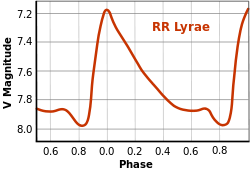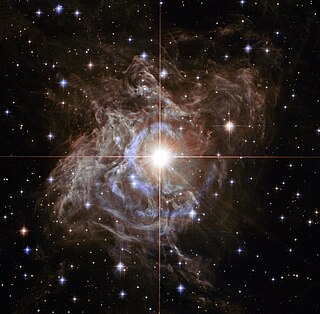
A Cepheid variable is a type of variable star that pulsates radially, varying in both diameter and temperature. It changes in brightness, with a well-defined stable period and amplitude.

RR Lyrae variables are periodic variable stars, commonly found in globular clusters. They are used as standard candles to measure (extra) galactic distances, assisting with the cosmic distance ladder. This class is named after the prototype and brightest example, RR Lyrae.

Beta Lyrae officially named Sheliak, the traditional name of the system, is a multiple star system in the constellation of Lyra. Based on parallax measurements obtained during the Hipparcos mission, it is approximately 960 light-years distant from the Sun.

Psi Virginis is a suspected binary star system in the zodiac constellation of Virgo. It can be seen with the naked eye and has an apparent visual magnitude of about 4.8. Based upon the annual parallax shift of 5.99 milliarcseconds, the distance to this star is roughly 540 light years. The angular size of Psi Virginis was measured on December 26, 1975 during an occultation by the Moon, yielding the estimate 6.5±0.3 mas.
Eta Lyrae, a name Latinized from η Lyrae, is a likely binary star system in the northern constellation of Lyra. It has the traditional name Aladfar and is faintly visible to the naked eye with an apparent visual magnitude of 4.43. The system is located at a distance of approximately 1,390 light years from the Sun based on parallax, but is drifting closer with a radial velocity of −8 km/s.

κ Lyrae, Latinized as Kappa Lyrae, is a solitary star in the northern constellation of Lyra, near the constellation border with Hercules. It is visible to the naked eye as a faint, orange-hued point of light with an apparent visual magnitude of 4.33. This object is located approximately 252 light years from the Sun based on parallax, but is moving closer with a radial velocity of −24 km/s.

R Lyrae, also known as its Flamsteed designation 13 Lyrae, is a 4th magnitude semiregular variable star in the constellation Lyra, approximately 350 light years away from Earth. It is a red giant star of the spectral type M5III, meaning it has a surface temperature of under 3,500 kelvins. It is much larger and brighter, yet cooler, than the Sun. In the near-infrared J band, it is brighter than the nearby Vega.

S Arae (S Ara) is an RR Lyrae-type pulsating variable star in the constellation of Ara. It has an apparent visual magnitude which varies between 9.92 and 11.24 during its 10.85-hour pulsation period, and it exhibits the Blazhko effect.
The Blazhko effect, also known as the Tseraskaya–Blazhko effect, and which is sometimes called long-period modulation, is a variation in period and amplitude in RR Lyrae type variable stars. It was first observed by Sergey Blazhko in 1907 in the star RW Draconis.
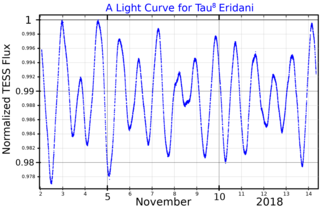
Tau8 Eridani, Latinized from τ8 Eridani, is a binary star system in the constellation Eridanus. It is visible to the naked eye with a combined apparent visual magnitude of 4.65. The distance to this system can be estimated via the parallax method, yielding a value of around 380 light years.

Zeta1 Lyrae, Latinized from ζ1 Lyrae, is a binary star in the northern constellation of Lyra. Based upon an annual parallax shift of 20.89 mas as seen from Earth, the pair are located about 156 light years from the Sun. It is visible to the naked eye with an apparent visual magnitude of 4.37.

Kappa Pavonis is a variable star in the constellation Pavo. It is the brightest W Virginis variable in the sky.

UY Scuti (BD-12°5055) is a red supergiant star in the constellation Scutum. It is considered to be possibly one of the largest known stars and is also a pulsating variable star, with a maximum brightness of magnitude 8.29 and a minimum of magnitude 10.56. It has an estimated radius of 909 solar radii thus a volume of 750 million times that of the Sun. This estimate implies if it were placed at the center of the Solar System, its photosphere would extend past the orbit of Mars.
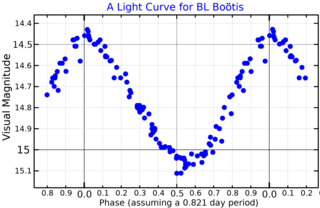
BL Boötis is a pulsating star in the constellation Boötes. It is the prototype of a class of anomalous Cepheids which is intermediate in the H-R diagram between the type I classical Cepheids and the type II Cepheids.

HP Lyrae is a variable star in the constellation Lyra, with a visual magnitude varying between 10.2 and 10.8. It is likely to be an RV Tauri variable, an unstable post-AGB star losing mass before becoming a white dwarf.

V473 Lyrae is a variable star in the constellation Lyra. It is an unusual Classical Cepheid variable with a visual range of 5.99 to 6.35.

FL Lyrae is the variable star designation for an eclipsing binary star system in the northern constellation of Lyra. The combined apparent magnitude of the pair is 9.36, which means they are too faint to be seen with the naked eye. Parallax measurements put the system at a distance of around 437 light years from the Sun. This star system was in the view field of the Kepler space telescope during 2009−2014, which allowed monitoring during that spacecraft's mission.
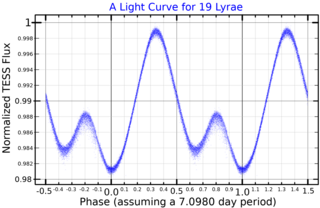
19 Lyrae is a single variable star located approximately 950 light years away from the Sun in the northern constellation of Lyra. It has the variable star designation V471 Lyr, while 19 Lyrae is the Flamsteed designation. This object is just bright enough to be visible to the naked eye, appearing as a dim, blue-white star with a baseline apparent visual magnitude of 5.93. It is moving closer to the Earth with a heliocentric radial velocity of −30 km/s, and may come as close as 167 light-years around 8.5 million years from now.
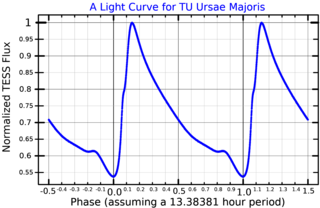
TU Ursae Majoris is a variable star in the northern circumpolar constellation of Ursa Major. It is classified as a Bailey-type 'ab' RR Lyrae variable with a period of 0.557648 days that ranges in brightness from apparent visual magnitude of 9.26 down to 10.24. The distance to this star is approximately 2,090 light years based on parallax measurements. It is located near the north galactic pole at a distance that indicates this is a member of the galactic halo.
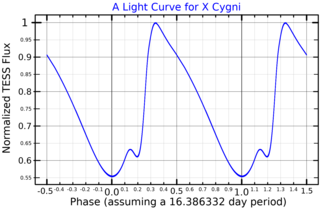
X Cygni is a variable star in the northern constellation of Cygnus, abbreviated X Cyg. This is a Delta Cephei variable that ranges in brightness from an apparent visual magnitude of 5.85 down to 6.91 with a period of 16.386332 days. At it brightest, this star is dimly visible to the naked eye. The distance to this star is approximately 628 light years based on parallax measurements. It is drifting further away with a radial velocity of 8.1 km/s. This star is a likely member of the open cluster Ruprecht 173.
